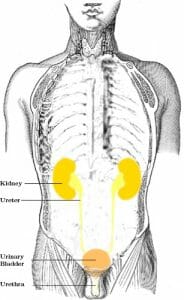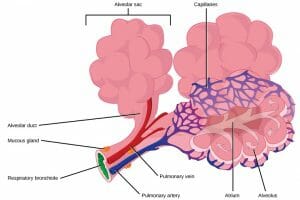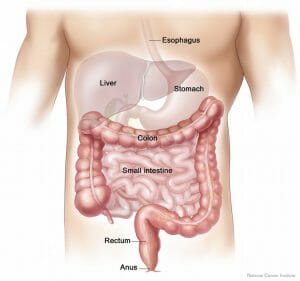The buildup of waste and excess materials in the human body can quickly throw it out of homeostasis, or even be fatal, without an efficient system of elimination. Wastes result from normal metabolic processes, the natural breakdown of other materials, and the death of cells. The excretory system is passive, meaning it requires no conscious thought or effort to function.
The Urinary System
The kidneys, ureter, urethra, and bladder make up the urinary system. Blood is filtered by the kidneys, removing nitrogenous wastes like urea, salts, and excess water. The leftover liquid is urine which passes through the ureter, into the bladder, and is excreted through the urethra.
Kidney stones can have a detrimental effect on the urinary system because they can lodge themselves in the urinary tract, blocking the flow of urine and causing pain. The stones come from a breakdown in the homeostatic mechanisms of the urinary system caused by dehydration, diet, obesity, and other medical conditions. The result is urine having high concentrations of minerals and salts which stick together and form stones.

The image above shows the main components of the urinary system.
The Respiratory System
The lungs expire gaseous wastes like carbon dioxide from the body. These gases arrive at the lungs from the tissues via the bloodstream. Specifically, gas exchange from the blood to the lungs (and vice versa) occurs by diffusion through capillary walls at the alveolar sacs.
Any damage to the lung tissue from smoking, asthma, disease, cancer, or other causes disrupts the homeostatic balance maintained by this part of the excretory system. Too much carbon dioxide building up in the blood causes fatigue, shortness of breath, confusion, headache, and metabolic acidosis. Very high levels can lead to coma and death.

The image above shows the capillary beds that surround alveoli (singular alveolus) in the lungs.
The Gastrointestinal Tract
By the time food reaches the large intestine (also known as the bowel or colon), most of the nutrients have been absorbed and what remains is primarily waste material. Wastes concentrate here and move through the sections of the colon—ascending, transverse, descending, and sigmoid and then to the rectum. Elimination occurs through the anus.
There are various diseases and conditions of the gastrointestinal tract that can disrupt the homeostasis. These include constipation, hemorrhoids, colitis, celiac disease, Crohn’s disease, diverticulitis, and irritable bowel syndrome.

The image above shows the components of the lower digestive system.
References
- Excretory System. (n.d.). In Wikipedia. Retrieved April 16, 2018 from https://en.wikipedia.org/wiki/Excretory_system
How Does the Excretory System Maintain Homeostasis
No comments:
Post a Comment